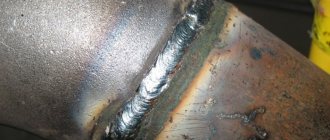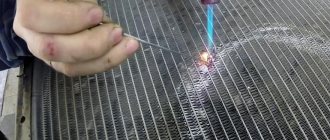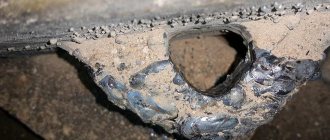Cold welding is a fairly universal way to repair various metal products, especially if such repairs need to be carried out quickly and the product must be put back into operation in a short time. Cases with pipes and heating radiators are no exception when they unexpectedly leak. In this case, cold welding can be a good help when performing repair work during a period when the heating season is not over, or when there is a need to urgently carry out repairs with virtually no interruption in the heating process of a residential or non-residential premises.
Currently, there are quite a large number of different options for cold welding, which can be used for different types of materials. In its appearance, cold welding is a special adhesive composition, which may contain various impurities or fillers, depending on the types of metals that will be joined using this composition.
Glue characteristics
The metal element is strong, and it is not so easy to connect it with each other. We need an effective substance. There are different types of good glue for metal.
Classified according to several criteria:
- Scope of application. Can be used both in everyday life and in industry;
- Resistance to low and high temperatures. There are heat-resistant ones. They can withstand temperatures up to 1000 degrees. And there are those that are not intended for use at high temperatures;
- Fast gluing. There are substances that harden quickly. (from one minute to fifteen). And there are some that take a long time to dry. Up to one day;
- The influence of aggressive chemicals on it. Some species, when exposed to chemicals, may dissolve or lose their properties. And there are glues that are resistant to chemicals;
- Adhesion (strength). It is the force with which a substance sticks two components together;
- Consistency. The form in which the substance is - liquid, gel, even solid.
Thus, for better results, consider the above characteristics when choosing a product.
Scope of application
Metal adhesive is used in various fields. This is heavy and light industry. Strong, resistant species are used here. In construction. It also requires glue that has high strength. There are also compositions with weaker characteristics that are used for domestic needs.
There are also some products designed for plastic, silicone, ceramics and other materials that can be used to glue metal to metal. And some other materials can also be glued with metal glue.
Properties of heat-resistant base
Before choosing an adhesive for metal, pay attention to how temperatures affect it. If the scope of application does not require high temperature, take conventional ones. If the product will be used at high temperatures, a special heat-resistant adhesive is needed.
Conventional ones have small application ranges relative to temperatures. Special heat-resistant ones - different in their characteristics. They can withstand from 100 to 1000 degrees, depending on the brand and type.
This type is also called “hot glue”, “hot melt”. It usually consists of many components. Most types are quite durable, set quickly, and are resistant to moisture.
Application area
The rapid development of industry using plastic materials has provoked the popularity of cold welding adhesive.
Main areas of use:
- Repair of plastic casings of technical products;
- Alignment and gluing of car body parts;
- Repair of fishing gear;
- Setting up sewer systems;
- Connecting plastic parts and assemblies.
Cold welding adhesive is used not only for joining plastic, it also firmly connects metal structures, wood, and other materials.
Types of glue for metal products
When choosing which glue is best for metal, it is worth looking at the types of these substances.
- Anaerobic. This type is good because when it dries, it becomes a solid polymer that tightly connects the two components. Does not react with chemical compounds. Can withstand up to 140 degrees.
- Water resistant. It is intended for those materials that are subject to constant exposure to water and moisture in general. Good for eliminating water leaks.
- Epoxy. It's universal. Used in many conditions. Resistant to aggressive chemicals. Resistant to different temperatures.
- Heat resistant. Designed for use in conditions of significant temperature changes. Withstands up to three hundred degrees. And some modifications reach up to a thousand.
- Cyanoacrylate. More or less universal. Used in different conditions. Very durable. Only not resistant to high temperatures, and dissolves in acetone.
What to look for when choosing
- You should definitely read the instructions to know exactly in what cases and for what materials to use.
- When using glue, the filler must match the type of metal surface being restored.
- The expiration date is not so important, but it is better to buy a product that is not expired.
- See what temperature cold welding can withstand, working and maximum range limits.
- Time for complete curing and immediate work in contact with the adhesive.
- Store consultants often give the right advice. Buying welding from a popular brand, a proven idea is to read the reviews. If previously they were wary or used incorrectly, now there are a lot of recommendations on this topic.
How to properly connect metal surfaces
When connecting components together, you need to consider how the structure will be used. If this is a fixed structure, you need a composition with strong adhesion. If it is constantly moving (for example, a staircase), an elastic component is needed.
IMPORTANT: each product has instructions that describe the properties, scope of application, and rules of use. They must be taken into account when using.
Proceed like this:
- Choose the appropriate adhesive for your situation (taking into account the scope of application, temperature, etc.);
- Read the instructions carefully;
- Prepare the surfaces. They need to be cleaned of rust and other contaminants. It is also important to degrease, for example using alcohol.
- Then, according to the instructions, apply the substance to the metals, combine, and hold until completely hardened. (The hardening time for each brand is different. It is indicated in the instructions).
In the video below you can see how metal is joined to metal:
Static rigid bonding of metals
Here adhesives are used that are capable of tightly bonding metal to metal. These are epoxy and cyanoacrylate glue. They have strong adhesion. Metal gluing must occur quickly. The entire area of the two parts of the material should be covered with an adhesive composition.
Deformation bonding of metals
If you need to glue two parts of constantly moving elements, you need fast-hardening metal glue. And at the same time elastic. Anaerobic, epoxy and heat-resistant glue are suitable.
In addition to gluing metal, which will be subject to constant deformation, there is “joining metals by deformation” - “cold welding”. This technology requires a special cold welding machine.
Epoxy resin
This adhesive composition forms a polymer, which is a fairly strong adhesive that tightly holds elements of two parts together. It is one of the best materials for gluing metal to metal.
Can be used for both interior and exterior work. It withstands temperatures well and is resistant to moisture. It hardens quickly, on average from one to five minutes, and complete hardening occurs within a day.
Instructions for use
Before using the material for repair purposes, you must study the operating rules and precautions.
Main rules of work
When purchasing raw materials in advance, in case of accidental breakdown, you need to take a universal remedy. And if, when going to the store for a repair product for a specific product, you should take into account the material from which the product is made.
During the work process the following rules are taken into account:
- The working surface requires thorough cleaning, drying, and degreasing.
- The mass is prepared by mixing liquid compounds or kneading part of the bar.
After preparing the mass, you have only five minutes to carry out repair work.
- The composition is applied to the workplace, the parts of the product are connected and fixed until completely dry. This process is accelerated by heating with a hairdryer.
- The excess is removed after hardening with sandpaper.
If you knead the material manually, you must wear gloves and moisten them with water. Humidity will prevent the raw material from sticking to the gloves.
You should not use sizing in severe frost, as the mass will be very difficult to soften.
When removing old raw materials, you must use a file or solvents.
Benefits of Metal Adhesive in Achieving Production Goals
At all times, different methods were used to connect two metals together. This includes riveting, welding, cold welding, and recently another method has emerged - gluing. The chemical industry has moved forward, and many components have emerged that can tightly join two pieces of metal.
This method is better than the previous ones. You can buy iron glue at any hardware store. Without much skill, connect two elements, and they will hold firmly. No welding, electricity or welding machines required. Only a small tube.
Using a welding machine you can join metal to metal, but you need a good machine and uninterrupted electricity. In addition, you need to know how to use it. You can buy glue at a hardware store, and, following safety precautions, connect the necessary elements according to the instructions. This is the advantage of this method.
What is cold welding
The term “cold welding” refers to two processes:
- Applying pressure to cold metal parts . As a result, plastic deformation of metals in the compression region and their connection occurs.
- Connecting parts using a special hardening compound.
The second type of cold welding is most widespread both in production and in everyday life. This type of connection will be considered next.
In fact, the “cold welding” product is an adhesive substance - epoxy glue, in which various additives are included to improve its characteristics.
When the resin is mixed with a hardener, it polymerizes and hardens. The result is a strong connection with good characteristics.
Review of manufacturers and brands
There are many manufacturers that make metal glue. Most brands can be purchased without difficulty in construction, hardware, and industrial stores.
Let's try to consider popular, frequently used brands, such as:
- Super Epoxy Moment;
- Maple 812;
- Poxipol;
- Weicon va 110;
- Quelyd 007 liquid metal;
- Strong steel stick;
- Weicon rk 1500;
- Epoximaxx;
- Bison super glue gel;
- Sun 10t.
In the video below, you can watch a short overview of adhesives used to glue metal to metal:
Super Epoxy Moment
Moment brand epoxy adhesive for metal. Like all epoxies, it can be used universally. Bonds all types of metals. Forms an elastic polymer seam. The downside of this glue, like all epoxies, is the long drying time. On average, from 12 hours to one day, depending on the external environment.
Maple 812
Heat-resistant adhesive for metal. In the form of a paste. Capable of withstanding up to 700 degrees. The strongest adhesive for metal. After hardening it becomes brittle. Cannot be processed further. Freezing takes an average of thirty hours.
Poxipol
Heat-resistant and water-resistant adhesive. Consists of two components, sold separately in one package. Before use you need to mix it, this is written in the instructions. Hardens quickly. The time is approximately ten minutes.
Expert advice
Experts recommend performing plastic repairs with extreme precision and reliability when correcting problems with pipes. This process requires a water-resistant mixture that will withstand constant exposure to liquids. The surfaces must be dried before application, which will increase adhesion. When repairing a leak in a plastic water pipe, you need to understand that this repair is temporary and you need to think about a major repair of the breakdown.
If the part to be glued is constantly exposed to vibration, then an additional pad should be applied to the joint.
You should not buy material that has expired. This will significantly reduce the performance of the seam on plastic.
We recommend watching the video:











